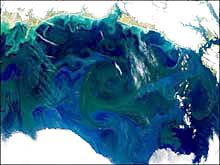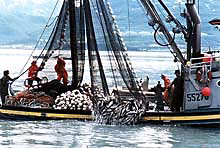
Eddies are rotating masses of water in the ocean that typically form along the boundaries of ocean currents. This true color image from the Sea-viewing Wide Field-of-view Sensor shows the green spiral of an eddy in bright blue water. Also notice the sediments suspended in the water along the south coast of Alaska. (Image provided by the SeaWiFS Project, NASA/Goddard Flight Center, and ORBIMAGE) Click image for larger view.
Mission Plan
Introduction
The Gulf of Alaska is a Pacific water body that is bordered by the southern coast of Alaska and the western coast of Canada. This glorious region is home to some of the largest glaciers on earth, and the cold, nutrient-rich waters of the Gulf support a diverse ecosystem that includes numerous species of fish and shellfish, as well as many marine mammals and large colonies of birds.
Much of this productivity is the result of eddies that transport warm coastal Gulf waters that are rich with nutrients far offshore into the cold nutrient poor waters in the middle of the Gulf. These nutrients provide nourishment for tiny microscopic plants called phytoplankton that form the foundation of the marine food chain. Read more about phytoplankton ![]() .
.
Large-scale industrial fishing occurs in this rich ecosystem that includes several commercially important fisheries such as crab, shrimp, pollock, salmon, and halibut. As a result of this massive fishing effort, several species of fish as well as snow crabs and other species of crab are overfished in the Gulf. Read more about crabs.
This biologically rich region is also extremely dynamic geologically and is the location of the second largest earthquake and resulting tsunami in recorded history. The geologic activity in the Gulf has also resulted in several volcanic seamount chains that have captured the attention of scientists from all over the world. These deep-sea mountains contribute to the biological richness of the Gulf, and are the focus of this expedition.
Goals of the Expedition
The goals of this OE expedition are to explore five previously unexplored volcanic seamounts in the Gulf of Alaska (GOA) to characterize their unique biota and habitats, and to determine how these undersea mountains formed.
More specifically. . .
The deep-sea submersible Alvin will be used at each seamount to collect samples and to develop a photographic inventory of benthic macrofauna during each dive. Comparisons will be made between seamounts, and depth transects will be conducted with the Alvin to examine depth distribution, habitat utilization and community structure of seamount organisms. A full-coverage swath bathymetry map of each seamount will be produced to search for tectonic and volcanic structures, and rock exposures will be sampled for age, duration, composition, and distribution of volcanic eruptions, and well as for microbiological studies. Reef-building deep-sea corals and sclerosponges will be collected to determine their potential for providing information about climate-ecosystem variability in the GOA, and the reproductive biology of some deep-sea coral samples will be examined. The genetic structure of deep-sea gorgonian corals will also be studied to determine whether seamount populations are genetically isolated units. Species distribution and habitat utilization of deep-sea crabs will be examined and live samples will be collected to determine biological characteristics such as species, sex, and reproductive condition. A ‘gentler' manipulator claw will be developed and tested on the Alvin to aid in the collection of live crabs. Observations will be made at various depth ranges where particular crab species are most abundant, to document reproductive or aggregative behaviors, as well as biological interactions with other species.
Anticipated Benefits
Most seamounts in the Gulf of Alaska have never been explored so there is great potential for new discoveries during this expedition. Because of their isolation, seamounts are known for high levels of speciation. Not surprisingly, a large percentage of seamount fauna has been found to be endemic in other regions of the world's oceans. We anticipate that the GOA seamounts will prove to be as biologically rich as others, and so ultimately the results of this expedition could have profound implications to aid in the protection of seamount fauna in the GOA. Other benefits of the expedition include gaining a more complete understanding of the geologic history of the GOA, and potentially adding to our current knowledge of historic climate and oceanic conditions of this dynamic region. Through our work we will also determine the importance of seamounts as essential habitats for unique and likely endemic species.
Outreach and Education
This expedition provides a wonderful educational opportunity to inform and excite the general public, as well as the scientific community, about unique and unexplored regions of the deep ocean environment. Outreach and education products will include detailed lesson plans that will target grades 5-12. Undergraduate and graduate students will benefit through post-cruise presentations by cruise participants at their respective institutions. An undergraduate student will also participate in the cruise, as will a K-12 educator, and they will assist with the collection of material for this Web site, through which the general public will be able to follow the expedition. The undergraduate student will be selected through the University of Alaska's Institute of Marine Sciences Alaska Native and Minority Student Internship/Mentoring Program. ![]() A team of professional videographers will be present throughout the cruise with the goal of developing an expedition video. This cruise will also provide an educational platform for the North Pacific Fisheries Observer Training Center
A team of professional videographers will be present throughout the cruise with the goal of developing an expedition video. This cruise will also provide an educational platform for the North Pacific Fisheries Observer Training Center ![]() , as one observer trainer will join the cruise, as will their new Director, Peter Risse. There is also potential for an Observer Training video to be developed from the footage collected during the Alvin dives.
, as one observer trainer will join the cruise, as will their new Director, Peter Risse. There is also potential for an Observer Training video to be developed from the footage collected during the Alvin dives.
Preliminary Cruise Plan
There will be two legs or sections to the cruise, and the preliminary cruise plan is as follows.
LEG 1
June 22-25 - Leave from Astoria, OR and transit to Murray Seamount.
June 26-July 2 - Explore Murray and Marchand Seamounts, and potentially dive at Chirikof Seamount as well.
July 3 - Arrive in Kodiak, AK for a one-day port call to offload live crabs, switch a few scientific crew, and provide public tours through invitation.
LEG 2
July 4 - Depart Kodiak, AK.
July 4-6 - Explore Chirikof and Marchand Seamounts, and potentially go back to Murray Seamount for a bit more exploration.
July 6-7 - Transit to Campbell Seamount.
July 7-13 - Explore Campbell and Warwick Seamounts.
July 14 - Transit back to Astoria, OR.
July 15 - Arrive in Astoria, OR.
The Alaska Seamount Exploration Team
The seamount exploration team will include scientists from the University of Alaska, Fairbanks, the National Marine Fisheries Service, Kodiak, Alaska, the University of California, Santa Cruz and Berkley campuses, Stanford University, Woods Hole Oceanographic Institution, and Oregon State University. An Alaskan native undergraduate student from the University of Alaska will also participate in the cruise, as will a K-12 educator, and a team of professional videographers will join the exploration team on the cruise with the goal of developing an expedition video that will target a general audience.
Sign up for the Ocean Explorer E-mail Update List.



























